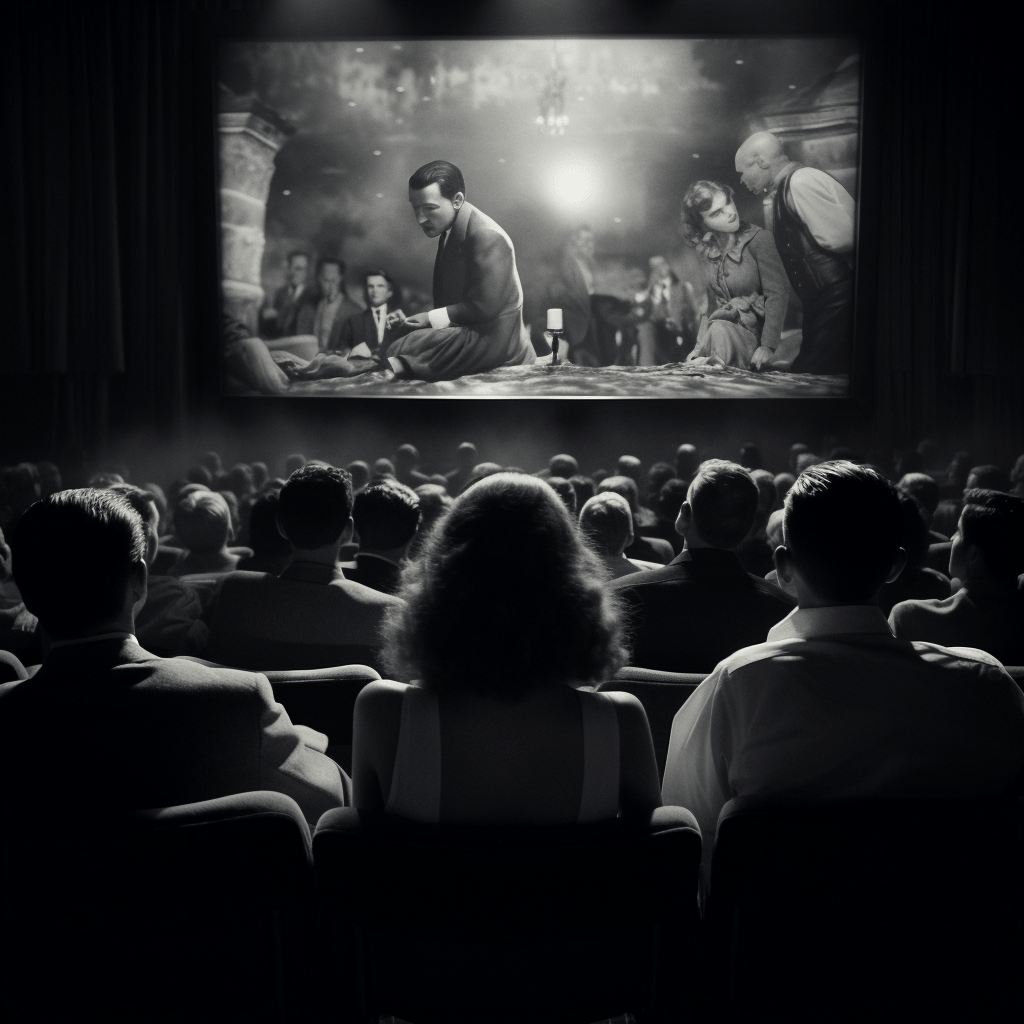
What's After the Blog?
Genres • Fan Theories
How Sci-Fi Films Predict and Influence the Future
Explore the fascinating world of sci-fi films and their profound role in predicting technological advancements and shaping future societal trends.
June 20, 2024

Movies mentioned in this article
How Sci-Fi Films Predict and Influence the Future
Introduction
Science fiction, a genre that has long fascinated audiences, serves as a canvas for exploring the realms of possibility, both in technology and society. These films often project the future, sometimes with uncanny accuracy, and have a profound impact on not just the audience’s imagination but also on the trajectory of technological and societal development. At ATM (What’s After the Movie), users can delve into a wide array of sci-fi movies, gaining insights into the visionary concepts that these films bring to life. From depicting advanced technologies to exploring ethical dilemmas in futuristic societies, sci-fi cinema continues to be a vital touchstone for envisioning and understanding the future.
The Origins of Sci-Fi in Cinema
The roots of science fiction in cinema can be traced back to the early 20th century, with films that dared to imagine the unimaginable. Classics like Georges Méliès’ A Trip to the Moon (1902) showcased early fascination with space travel, long before it became a reality. As the genre evolved, it began to reflect the rapidly changing technological landscape and the societal implications of these advancements.
Films like Fritz Lang’s Metropolis (1927) not only pushed the boundaries of special effects and set design but also offered a critical commentary on industrialization and class struggle. The 1950s and 1960s saw a surge in sci-fi cinema, with films like Forbidden Planet and 2001: A Space Odyssey exploring themes of space exploration, artificial intelligence, and human evolution. These films, while being products of their time, also shaped public perception and expectations of the future.
The evolution of sci-fi cinema has mirrored technological and scientific advancements. In the 1980s and 1990s, with the advent of computers and the internet, films like Blade Runner and The Matrix delved into cyberpunk themes, exploring the intersection of humanity and technology. These films offered a glimpse into potential futures, where virtual realities and AI are integral parts of life.
Sci-fi films have also been prescient in predicting future technologies. 2001: A Space Odyssey famously depicted tablet computers decades before they became a reality. Similarly, Minority Report anticipated advancements in gesture-based computing and biometric security. By imagining the future, these films have not only predicted technological advancements but have also influenced their development.
In summary, the origins and evolution of sci-fi cinema demonstrate its enduring appeal and significance. These films provide more than entertainment; they offer a vision of the future that can inspire, warn, and provoke thought, making them an essential part of our cultural and technological landscape.
Sci-Fi as a Mirror of Societal Hopes and Fears
Science fiction films have long served as mirrors, reflecting societal hopes and fears while projecting them into futuristic narratives. These movies often encapsulate the zeitgeist, highlighting contemporary issues through the lens of future possibilities. For example, Blade Runner and Metropolis are not just about advanced technology but also about the societal implications of such progress. They delve into themes like the erosion of human values, the widening gap between social classes, and ethical dilemmas surrounding artificial life. Similarly, The Day the Earth Stood Still addresses the fear of nuclear annihilation during the Cold War era, using an extraterrestrial visit as an allegory for the need for peace and understanding among nations.
On the flip side, films like Star Trek offer a more hopeful vision of the future, where humanity has overcome many of its contemporary challenges and explores the galaxy in peace. This optimistic portrayal reflects a desire for a future where technological advancements are used for the betterment of mankind, fostering unity and exploration. Sci-fi movies, therefore, are not just escapist fantasies but are deeply rooted in the realities of their times, offering a space to explore the consequences of current actions and decisions on the future.
Breakthrough Sci-Fi Films and Their Predictions
Several sci-fi films have been remarkably prescient in their predictions, foreseeing technological innovations and societal changes long before they became reality. 2001: A Space Odyssey is renowned for its accurate portrayal of space travel and predicted inventions like video calling and AI assistants, which are now integral parts of our lives. Minority Report, with its depiction of personalized advertising and predictive policing, foresaw the rise of big data and its implications for privacy and law enforcement.
These films often influence the very technologies they predict. Engineers and scientists have cited movies like Star Trek and Iron Man as inspiration for innovations in communication devices, user interfaces, and even space exploration. The predictive nature of these films is not merely coincidental; it stems from their creators’ understanding of the trajectory of technological advancements and their possible impacts on society.
In essence, breakthrough sci-fi films serve a dual purpose: they not only predict the future but also inspire the innovations that shape it. By presenting a vision of what might be, these films encourage us to strive towards those possibilities, influencing the course of technological and societal development.
The Influence of Sci-Fi on Technological Advancements
The impact of science fiction films on real-world technological advancements is both profound and well-documented. These films often serve as a source of inspiration for scientists, engineers, and technologists, pushing them to turn science fiction into science fact. For instance, the iconic communicator devices in Star Trek closely resemble today’s smartphones, while the concept of virtual reality, popularized by movies like The Matrix, has become a significant field of technological research and development.
This influence extends beyond specific gadgets to broader technological concepts and ethical considerations. Films like Ex Machina and Her explore the intricacies of artificial intelligence and the moral implications of creating sentient machines. These narratives prompt critical thinking and dialogue within the tech community, influencing the direction of AI research and development with a more conscious approach to ethics and impact.
Moreover, sci-fi films often portray futuristic medical technologies, inspiring advancements in healthcare and biotechnology. The medical bays in Star Trek or the regenerative technologies in Elysium push medical professionals and researchers to innovate in areas like telemedicine, prosthetics, and regenerative medicine. The visionary ideas presented in these films provide a catalyst for technological breakthroughs, shaping the future of various industries.
Sci-Fi and Social Change: Shaping Public Perception
Science fiction films also play a critical role in shaping public perception and discourse around emerging technologies and future societal challenges. By presenting hypothetical scenarios, these films allow audiences to contemplate the potential impacts and ethical dilemmas of technological advancements, influencing public opinion and, in some cases, policy.
For instance, films like Interstellar and The Martian have reignited interest in space exploration and the possibility of colonizing other planets. These films contribute to a public narrative that supports space programs and scientific research. Similarly, dystopian films like The Hunger Games and Snowpiercer offer commentary on issues like social inequality and climate change, sparking conversations about these critical issues in a broader context.
In many ways, sci-fi films act as a societal litmus test, presenting futuristic concepts to the public and gauging their reactions. These films can both reflect and influence public attitudes towards technology and its role in society, making them powerful tools for social commentary and change.
In conclusion, science fiction films play a multifaceted role in predicting and influencing the future. From inspiring technological innovations to shaping public perceptions and societal discourse, these films are not just a form of entertainment but a significant driver of progress and change. For movie enthusiasts and tech aficionados alike, exploring these films through resources like ATM (What’s After the Movie) offers a deeper appreciation of their impact and significance.
Conclusion
The interplay between science fiction films and the future is a symbiotic one, where art inspires life, and life, in turn, influences art. As we have seen, sci-fi movies do more than entertain; they challenge us to think, dream, and innovate. They are a testament to human creativity and our quest to understand and shape our destiny. As we continue to advance technologically and socially, these films will remain crucial in exploring the possibilities and responsibilities that come with such progress. For those curious about the intricate relationship between cinema and technological advancement, ATM (What’s After the Movie) offers a gateway to explore these visionary films and their lasting impact on our world.
Invitation to Explore More
We hope this journey into the world of science fiction and its influence on the future has been as enlightening for you as it has been for us. The realm of sci-fi cinema is vast and full of insights about our past, present, and potential futures. We invite you to delve deeper into this fascinating genre and explore the many other insights available on What’s After the Movie’s blog. Whether you’re a science fiction enthusiast or simply curious about the interplay between cinema and technology, there’s always something new and exciting to discover in the world of sci-fi films.
Continue reading

What's After the Movie?
Not sure whether to stay after the credits? Find out!
Check out our other apps:
Actors
Companies
Latest Movies
© 2025 What's After the Movie. All rights reserved.





















